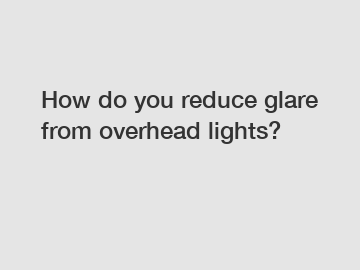Nov. 28, 2023
Electronic Components & Supplies
How do you reduce glare from overhead lights?
Overhead lights are a common source of glare that can be not only annoying but also affect productivity and overall well-being. Glare can cause eyestrain, headaches, and even difficulty concentrating. Fortunately, there are several effective strategies to reduce glare from overhead lights, allowing you to create a more comfortable and conducive environment. In this article, we will explore some practical approaches to minimizing glare and improving your lighting conditions.
Adjust the Position of Lights.

One of the simplest yet effective ways to reduce glare from overhead lights is by adjusting their position. The angle and direction of the lights can greatly impact the amount of glare they produce. If possible, try tilting the lights away from direct line of sight or repositioning them to shine on walls or ceilings instead of directly on work surfaces, such as desks or computer screens. By doing so, the light will be diffused and scattered, minimizing harsh glare.
Use diffusers or Filters.
Another great option to reduce glare is to use diffusers or filters with your overhead lights. Diffusers are translucent covers that are placed over light fixtures, dispersing light evenly and reducing the intensity of glare. Similarly, filters can be attached to light bulbs to soften their illumination and minimize the harshness of the light. These accessories can make a significant difference in reducing glare and creating a more comfortable lighting environment.
Opt for Dimming Options.
Further reading:Dimming the overhead lights can also be an effective solution to reduce glare. By lowering the brightness of the lights, you can create a softer and more soothing illumination that is less likely to cause discomfort or eye strain. Installing dimmer switches or using lamps with adjustable settings can give you greater control over the lighting levels in your space, allowing you to find the perfect balance between functionality and comfort.
Utilize Task Lighting.
In some cases, overhead lights might not be necessary, especially if you have other sources of lighting available. Consider incorporating task lighting into your workspace to provide focused illumination on the specific areas where you need it the most. Desk lamps or floor lamps with adjustable heads can help redirect light to the work surface, reducing the need for bright overhead lights. This targeted lighting approach can greatly minimize glare and improve visibility during specific tasks or activities.
Optimize Natural Lighting.
If possible, maximize the use of natural lighting in your workspace. Natural light is softer and more diffused compared to artificial light, making it less likely to cause glare. Position your work area near a window or an area with abundant natural light. You can also use window treatments, such as blinds or curtains, to control the amount of light entering the space and prevent direct sunlight from causing glare on reflective surfaces.
In conclusion, reducing glare from overhead lights is essential for creating a comfortable and productive environment. By adjusting the position of the lights, using diffusers or filters, utilizing dimming options, incorporating task lighting, and optimizing natural lighting, you can effectively minimize glare and enhance your overall lighting conditions. Experiment with these techniques to find the best combination that works for you. If you need further assistance or have any questions, please do not hesitate to contact us.
Want more information on indoor smd led display Products, radar speed control signs, led arrow board? Feel free to contact us.
Further reading:Previous: What does CBB60 mean on a capacitor?
Next: Alphanumeric LCD Displays: Which Design Will Revolutionize the Industry?
Related Articles
If you are interested in sending in a Guest Blogger Submission,welcome to write for us!
All Comments ( 0 )